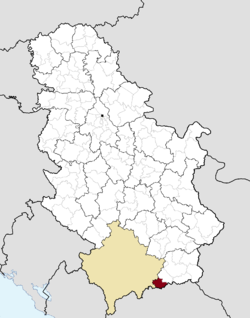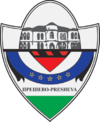Presevo
|
Preševo Прешево Presheva |
|||
|---|---|---|---|
| Town and municipality | |||
| Preševo | |||

Preševo overview
|
|||
|
|||
 Location of the municipality of Preševo within Serbia |
|||
| Coordinates: 42°18′20″N 21°38′34″E / 42.30556°N 21.64278°ECoordinates: 42°18′20″N 21°38′34″E / 42.30556°N 21.64278°E | |||
| Country |
|
||
| Region | Southern and Eastern Serbia | ||
| District | Pčinja | ||
| Settlements | 35 | ||
| Government | |||
| • Mayor | Ardita Sinani (PVD) | ||
| Area | |||
| • Municipality | 264 km2 (102 sq mi) | ||
| Elevation | 463 m (1,519 ft) | ||
| Population (2002 census) | |||
| • Town | 13,426 | ||
| • Municipality | 34,904 | ||
| Time zone | CET (UTC+1) | ||
| • Summer (DST) | CEST (UTC+2) | ||
| Postal code | 17523 | ||
| Area code | +381(0)17 | ||
| Car plates | VR | ||
| Website | www |
||
Preševo (Serbian Cyrillic: Прешево, pronounced [prêʃeʋo]; Albanian: Presheva, Preshevë) is a town and municipality located in the Pčinja District of the southern Serbia. It is the southernmost city in Serbia, the largest town in the geographical region of Preševo Valley, and the cultural center of Albanians in Serbia.
According to the 2002 census, the town of Preševo had a population of 13,426 people, while the municipality had 34,904 inhabitants. Albanians form the ethnic majority of the municipality, followed by Serbs, Roma and other ethnic groups.
The municipality of Preševo has been populated by ethnic Albanians since the time of Illyrian tribes (Dardanians) presence in Balkan. Serbs since roughly the 6th century, when they first migrated to the Balkans, and by the Middle Ages, Preševo was part of the Kingdom of Serbia. According to Stefan Dušan's charter to the monastery of Arhiljevica dated August 1355, sevastokrator Dejan possessed a large province east of Skopska Crna Gora. It included the old župe (counties) of Žegligovo and Preševo (modern Kumanovo region with Sredorek, Kozjačija and the larger part of Pčinja). As despot under the rule of Uroš V, Dejan was entrusted with the administration of the territory between South Morava, Pčinja, Skopska Crna Gora (hereditary lands) and in the east, the Upper Struma river with Velbuzhd, a province notably larger than during Dušan's life. After the death of Dejan, his province, besides the župe of Žegligovo and Upper Struma, was appropriated to nobleman Vlatko Paskačić. Dejan's eldest son Jovan also received the title of despot, like his father before, by Emperor Uroš. In the new redistribution of feudal power, after 1371, the brothers despot Jovan and gospodin Konstantin greatly expanded their province. Not only did they recreate their father's province but also at least doubled the territory, on all sides, but chiefly towards the south. Ottoman sources report that in 1373, the Ottoman army compelled Jovan (who they called Saruyar) in the upper Struma, to recognize Ottoman vassalage. As Prince Marko had done, also the Dejanović brothers recognized Ottoman sovereignty. Although vassals, they had their own government. In the Wallachian victory at the Battle of Rovine (17 May 1395), both Marko and Konstantin died. The provinces of Marko and Konstantin became Ottoman.
...
Wikipedia


